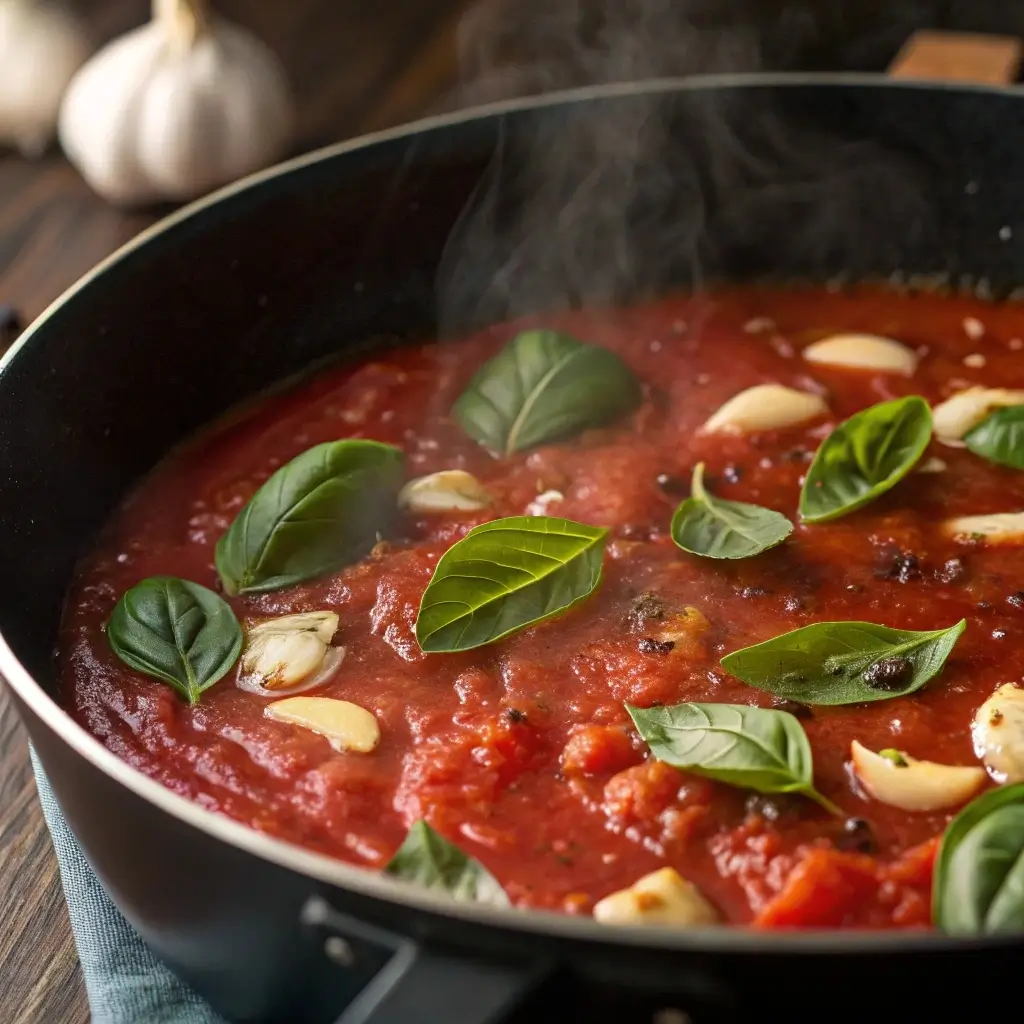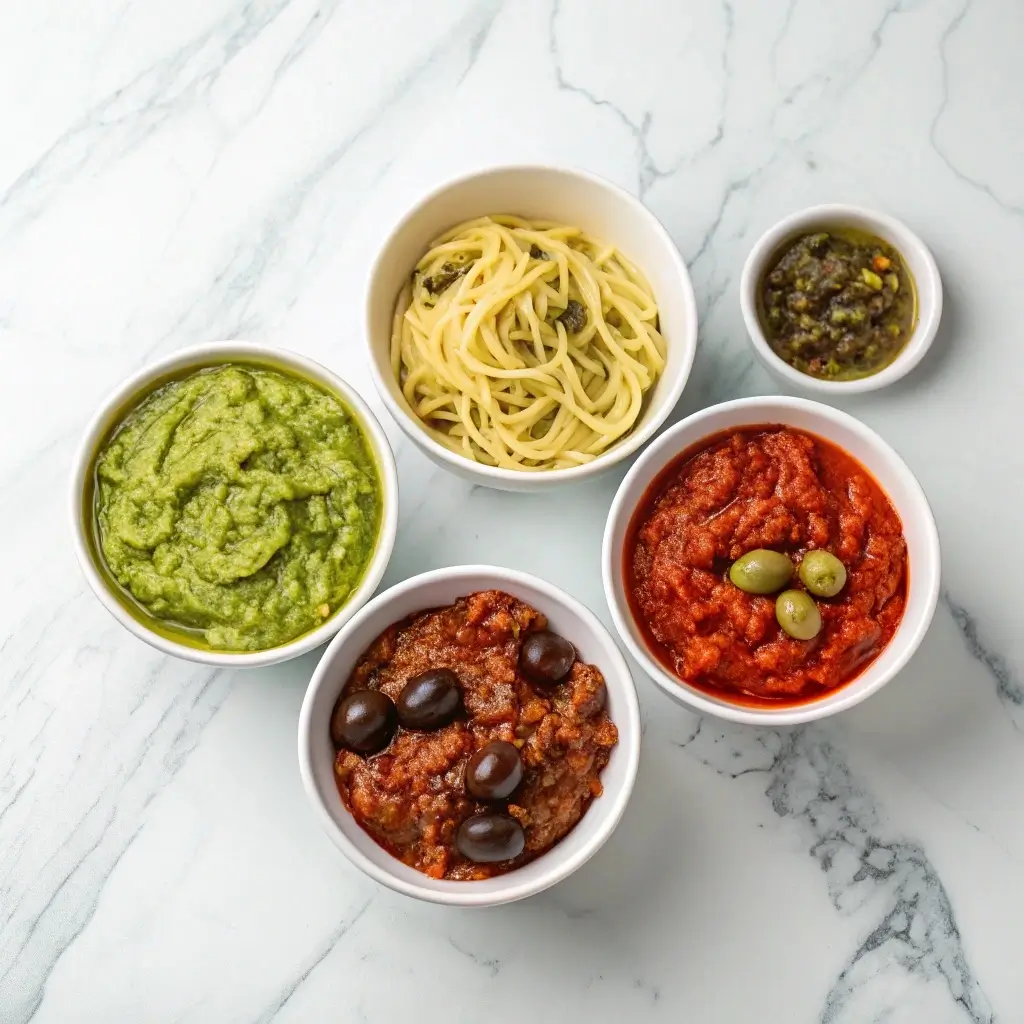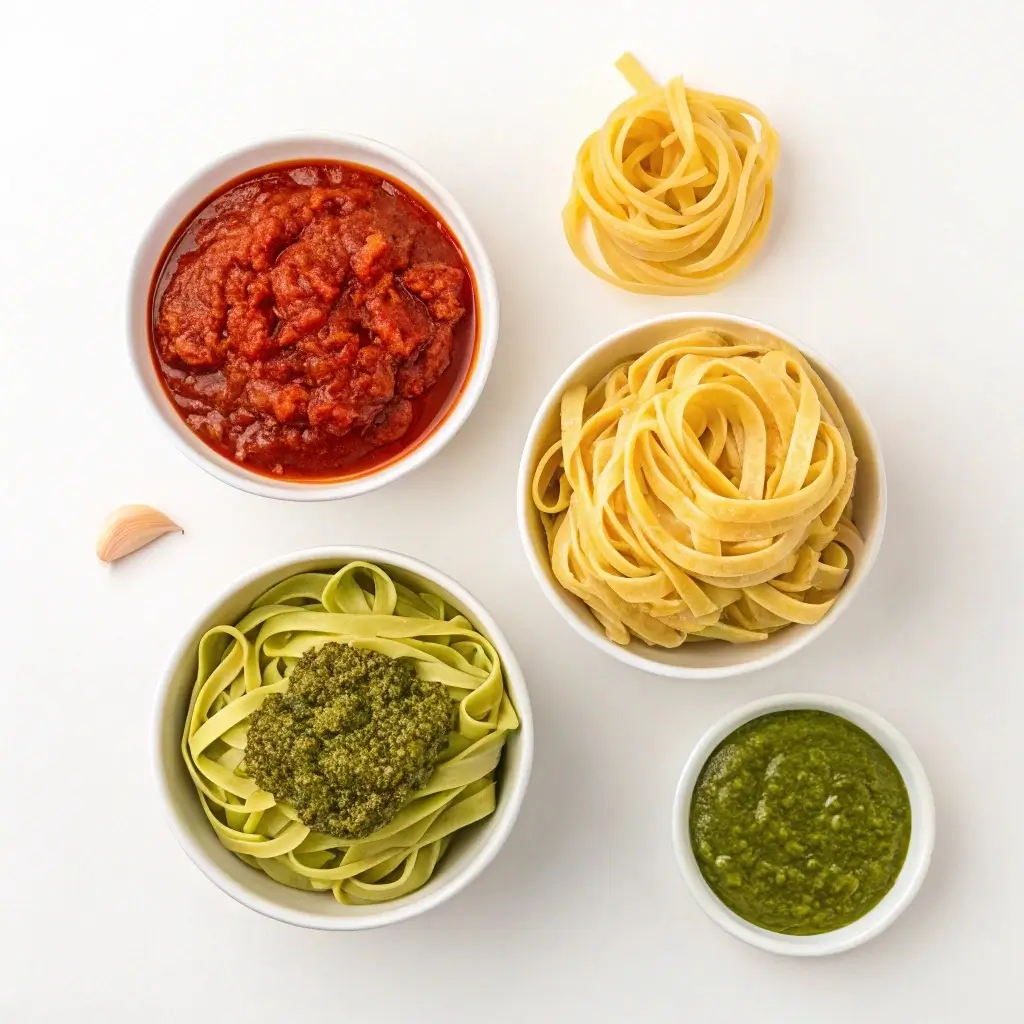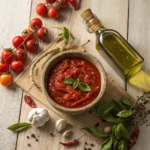When someone mentions Italian cuisine, what’s the first thing that comes to mind? Pasta, of course—and with it, the rich, fragrant sauces that make each dish sing. From the bold flavor of marinara to the creamy decadence of carbonara, sauces are the soul of Italy’s cooking traditions. But what is Italy’s most famous sauce? Is it the one found in every pantry, or the one Nonna simmers on the stove for hours?
This article uncovers the answer by diving deep into Italian culinary roots. We’ll explore classic sauces, regional favorites, and why marinara stands at the top. Whether you’re a home cook, food blogger, or pasta lover, you’re about to discover why Italians—and the world—adore their sauces.
👉 Check out our Italian Meat Sauce Recipe for a rich and hearty spin on tradition.
Sauce as the Heart of the Italian Table
In Italian cuisine, sauce is more than just a topping—it’s a tradition. It’s what ties generations together, passed down from grandmothers who never wrote a recipe, only cooked by feel, smell, and soul. Sauces are often the first thing simmering in the kitchen before the pasta water even boils. And when people around the world ask what is Italy’s most famous sauce, they’re really asking about the flavor of that heritage.
A Symbol of Regional Identity
Italy isn’t one flavor fits all. Each region has its own sauce legacy:
- Naples: Home of the original marinara, simple and tomato-based
- Bologna: Birthplace of ragù (Bolognese), slow-cooked and meat-rich
- Liguria: Known for fresh pesto Genovese
- Rome: The creamy glory of carbonara and cacio e pepe
These iconic recipes help us explore what is Italy’s most famous sauce, as each region has its own claim to the crown. Every sauce reflects the ingredients most abundant locally—basil in Liguria, pork in Emilia-Romagna, tomatoes in Campania.
Everyday Meals to Celebration Dishes
Sauce in Italy is not reserved for special occasions. It’s part of daily life—from penne with sugo (tomato sauce) on a Tuesday to Sunday feasts stacked with lasagna bolognese. The preparation may change, but the cultural importance remains at the core of the question: what is Italy’s most famous sauce, and why has it stood the test of time?
Discover great ideas like our Homemade Spaghetti Sauce to Can for preserving Italian flavor all year round.
What is Italy’s Most Famous Sauce? Marinara Takes the Crown
And the Winner Is… Marinara Sauce
Ask an Italian Nonna, a New York chef, or even a kid twirling spaghetti at dinner—marinara sauce is hands-down Italy’s most iconic and beloved sauce. It’s the red, garlicky, herb-infused foundation of Italian-American cooking and the blueprint for endless variations across the country.
What Makes Marinara So Famous?
Simplicity. Marinara is made from just a handful of ingredients: ripe tomatoes, olive oil, garlic, salt, and fresh herbs—usually basil or oregano. But don’t be fooled by the short ingredient list. When prepared right, marinara bursts with vibrant flavor that makes it a go-to for pizza, pasta, meatballs, and even dipping breadsticks.
It’s also:
- Quick to make – often ready in under 30 minutes
- Vegan-friendly – no meat or dairy involved
- Highly versatile – pairs with everything from spaghetti to seafood
Marinara is the sauce that represents Italy’s cooking ethos: quality ingredients, treated with respect.
A Brief History of Marinara
The word “marinara” comes from “alla marinara”, meaning “sailor-style.” Legend says this sauce was first created by Neapolitan sailors in the 16th century after tomatoes were introduced to Europe. The ingredients were shelf-stable and perfect for long sea voyages.
It eventually became a staple across southern Italy, especially in Naples—the spiritual home of pizza and simple tomato sauces.

Don’t miss our Lazy Lasagna Recipe which pairs perfectly with marinara for a weeknight Italian classic.
Why Marinara Is Considered Italy’s Most Famous Sauce
Pesto Genovese – The Green Glory of Liguria
While marinara may be the most famous, pesto is a close second—and a regional treasure from Liguria. Made with:
- Fresh basil
- Garlic
- Pine nuts
- Parmigiano-Reggiano
- Olive oil
This raw sauce is bold, aromatic, and vibrant green. Traditionally served with trofie pasta, pesto is all about freshness. Today, it’s also popular in sandwiches, pizzas, and even on eggs.
Looking for inspiration? Try our Pesto and Alfredo Sauce Pairings for creative fusion ideas.
Bolognese (Ragù) – The Hearty Northern Classic
Also known as ragù alla bolognese, this sauce from Bologna is rich, meaty, and slow-cooked to perfection. It typically includes:
- Ground beef and pork
- Tomato paste
- Carrots, onions, and celery
- Red wine
- Milk or cream
Simmered for hours, Bolognese clings to wide pastas like tagliatelle or is layered in lasagna. It’s Italy’s answer to comfort food.
Carbonara – Creamy (But Without Cream)
This Roman icon is often misunderstood—true carbonara contains no cream. Just:
- Eggs
- Pecorino Romano cheese
- Guanciale (cured pork cheek)
- Black pepper
The heat of the pasta cooks the eggs into a silky, rich coating. Spaghetti or rigatoni are the usual partners. It’s indulgent yet deceptively simple.
Honorable Mentions
- Amatriciana – spicy tomato and guanciale from Lazio
- Cacio e Pepe – just cheese and pepper, incredibly satisfying
- Putanesca – bold and briny, with olives and capers
Each of these sauces plays a unique role in Italy’s food story—adding depth, regional pride, and endless mealtime variety.

Best Italian Sauces to Pair with Pasta
Not All Pasta Is Created Equal
In Italy, pairing sauce with pasta isn’t random—it’s an art. The pasta’s shape, texture, and ridges all play a role in how well it holds onto sauce. Choosing the right combo isn’t just tradition; it enhances the entire eating experience.
So once you know what is Italy’s most famous sauce, you’ll also want to know how to serve it right.
Best Sauce Pairings by Pasta Type
| Pasta Shape | Best Sauce Match | Why It Works |
|---|---|---|
| Spaghetti | Marinara, Carbonara | Long strands hold light, oily, or creamy sauces well |
| Penne | Arrabbiata, Bolognese | Hollow tubes trap chunky sauces |
| Tagliatelle | Bolognese | Wide ribbons support meaty, heavy sauces |
| Trofie | Pesto Genovese | Short, twisted pasta captures thick, raw sauces |
| Bucatini | Amatriciana | Tube-within-a-strand structure soaks up savory oils |
Light vs Hearty: Match by Weight
Think of it like wine pairing: lighter pastas (like angel hair) work best with light, smooth sauces. Heartier shapes (like rigatoni or pappardelle) need bold, dense sauces that coat every bite.
How Italians Really Dress Their Pasta
Forget drowning your noodles in sauce. Italians believe in lightly coating pasta—just enough to complement, not overpower. In fact, in many homes across Italy, the pasta and sauce are tossed together before serving so the flavors marry perfectly.
Don’t miss our Meatballs and Alfredo Sauce for a bold twist on classic pairings!
PART 5: Traditional Ingredients and Techniques
The Beauty of Simplicity
Italian sauces are world-renowned not because they’re complicated—but because they celebrate simplicity. The magic lies in using high-quality, seasonal ingredients and applying the right cooking technique.
For example, the secret to a memorable marinara isn’t how long you cook it—it’s how good your tomatoes are.
Essential Ingredients in Famous Italian Sauces
| Ingredient | Why It Matters |
|---|---|
| Tomatoes | San Marzano or vine-ripened for sweetness and acidity |
| Olive Oil | A fruity, peppery base that ties flavors together |
| Garlic | Adds warmth and depth—sautéed gently, never burned |
| Onion | Optional, but adds sweetness in slow-cooked sauces |
| Fresh Basil | Used in marinara and pesto for its aroma and freshness |
| Parmigiano or Pecorino | Used as a finisher or base in creamy sauces |
| Guanciale | A rich, fatty meat used in Carbonara and Amatriciana |
These staples vary slightly by region, but they’re the building blocks of Italy’s most famous sauce recipes.
Slow and Low: The Italian Way
Traditional sauces are often simmered over low heat for long periods. For example:
- Bolognese is cooked for at least 2–3 hours, allowing the meat and tomato base to fully combine
- Marinara, on the other hand, is usually ready in 30 minutes or less to keep the tomato taste fresh and vibrant
Italians also layer flavors, sautéing garlic in olive oil before adding tomatoes, or toasting spices to bring out their full aroma.
Modern Twists on Old-World Recipes
While many chefs stick to tradition, modern kitchens have adopted creative twists:
- Using roasted garlic for sweeter notes
- Swapping basil for arugula or spinach in pesto
- Adding a splash of red wine to deepen ragù

Learn more about layering flavor with our Hamburger Meat Alfredo Sauce Recipe—a creamy fusion of American and Italian inspiration.
Store-Bought vs Homemade Italian Sauces
Is Homemade Always Better?
In most Italian kitchens, homemade sauce is a point of pride. Whether it’s a quick 20-minute marinara or a slow-simmered ragù, homemade sauces allow total control over ingredients and flavor.
That said, not everyone has the time or tomatoes. So where do store-bought sauces stand?
When to Go Store-Bought
Quality jarred sauces have come a long way—and when chosen carefully, they can deliver great flavor and convenience. Look for:
- Short ingredient lists
- No added sugar or preservatives
- Cold-pressed olive oil instead of vegetable oil
- Brands that use San Marzano tomatoes or organic ingredients
Top-rated brands like Rao’s Homemade, Bertolli Rustic Cut, and La San Marzano are often recommended for their authentic taste.
How to Upgrade Jarred Sauce Like an Italian
If you’re using a jar, treat it like a base. Here’s how to elevate it:
| Upgrade | Effect |
|---|---|
| Sauté fresh garlic or onions | Adds homemade depth |
| Stir in a spoonful of tomato paste | Boosts umami and richness |
| Add chopped fresh basil or oregano | Brightens the flavor |
| Finish with butter or olive oil | Rounds out acidity |
Even just simmering the jarred sauce with a splash of pasta water can make it cling to noodles like the real thing.
Try our Cheese on Jambalaya to explore how cheese and sauce elevate simple meals in any cuisine.
FAQs About Italy’s Most Famous Sauce
What are two Italian sauces?
Two of the most iconic Italian sauces are Marinara and Pesto Genovese. Marinara is tomato-based, simple, and found across southern Italy. Pesto, from Liguria, is made with fresh basil, pine nuts, olive oil, garlic, and Parmesan—a raw, bright green sauce packed with flavor.
Which Italian sauce is often served with pasta?
Marinara sauce is the most commonly served sauce with pasta, especially spaghetti. It’s a staple in Italian households and restaurants alike, praised for its light texture, fresh tomato flavor, and quick prep time.
What is the most popular sauce for pasta?
Hands down, marinara is the most popular. It’s versatile, vegan-friendly, and used as a base for many other dishes, from lasagna to pizza. Its balance of sweetness and acidity makes it universally loved.
What do Italians put on their pasta?
Italians typically use olive oil, grated cheese (like Parmigiano or Pecorino), and freshly made sauces. Unlike American-style pasta, they don’t drown noodles in sauce—they lightly coat them for flavor and texture harmony.
Conclusion
So, what is Italy’s most famous sauce? Without a doubt—marinara wears the crown. It’s humble, vibrant, and speaks to the very heart of Italian cooking: simplicity, tradition, and flavor. But it’s not alone. From pesto’s fragrant punch to Bolognese’s hearty richness, Italy offers a sauce for every region, every pasta shape, and every craving.
Whether you’re simmering tomatoes on a Sunday afternoon or twisting a fork into pesto-dressed trofie, Italian sauces bring people together—just like they have for generations.
Don’t miss our Homemade Spaghetti Sauce to Can to carry Italy’s most iconic flavors into every season.
If you’re passionate about Italian food and want more inspiration beyond this guide on what is Italy’s most famous sauce, follow us on Pinterest for daily ideas, regional recipes, and pasta-perfect sauce boards.
PrintClassic Italian Marinara Sauce
A simple, vibrant, and authentic marinara sauce made with just a few ingredients—perfectly capturing the flavor of Italy’s most famous sauce. Ideal for pasta, pizza, and dipping bread, this recipe is quick, fresh, and timeless.
- Prep Time: 5 minutes
- Cook Time: 25 minutes
- Total Time: 30 minutes
- Yield: 4–5 servings (about 3 cups sauce) 1x
- Category: Sauce
- Method: Simmering
- Cuisine: Italian
Ingredients
2 tbsp extra virgin olive oil
3 cloves garlic (minced)
1 can (28 oz) crushed San Marzano tomatoes
½ tsp salt (or to taste)
½ tsp dried oregano
¼ tsp crushed red pepper flakes (optional)
5–6 fresh basil leaves (torn by hand)
½ tsp sugar (optional, to balance acidity)
Instructions
Heat olive oil in a large skillet or saucepan over medium heat.
Add minced garlic and sauté for 30 seconds until fragrant (don’t let it brown).
Pour in crushed tomatoes, salt, oregano, and red pepper flakes. Stir to combine.
Let the sauce simmer uncovered for 20–25 minutes, stirring occasionally.
Turn off heat, stir in torn basil leaves and sugar if needed.
Taste and adjust seasoning. Serve immediately or let cool for storage.
Notes
Use whole San Marzano tomatoes and crush them by hand for a more rustic texture.
Sauce keeps for up to 5 days in the fridge or 2 months in the freezer.
For smoother sauce, blend after simmering.
Great as a base for pizza, pasta, lasagna, and more.
Nutrition
- Serving Size: ½ cup
- Calories: 90 kcal
- Sugar: 5g
- Sodium: 330mg
- Fat: 6g
- Saturated Fat: 1g
- Unsaturated Fat: 5g
- Carbohydrates: 8g
- Fiber: 2g
- Protein: 2g





